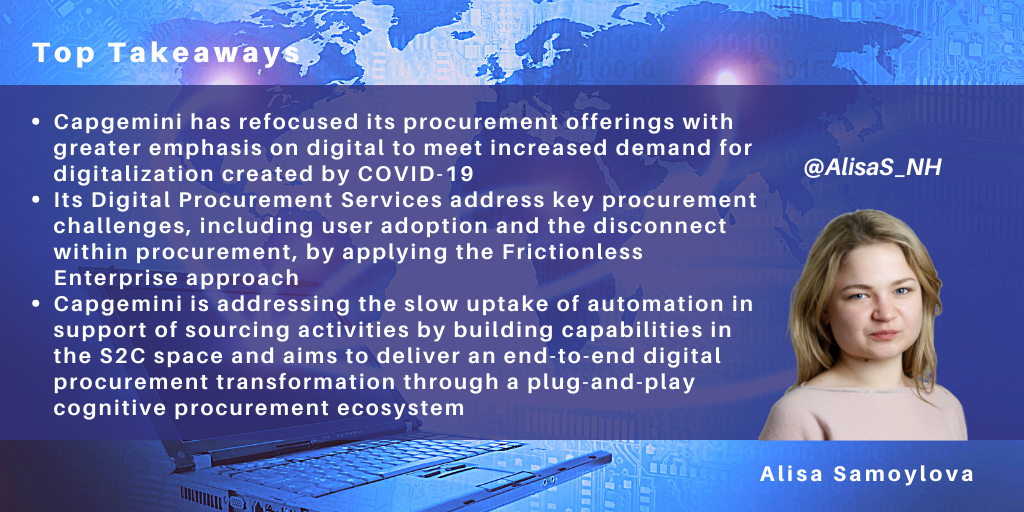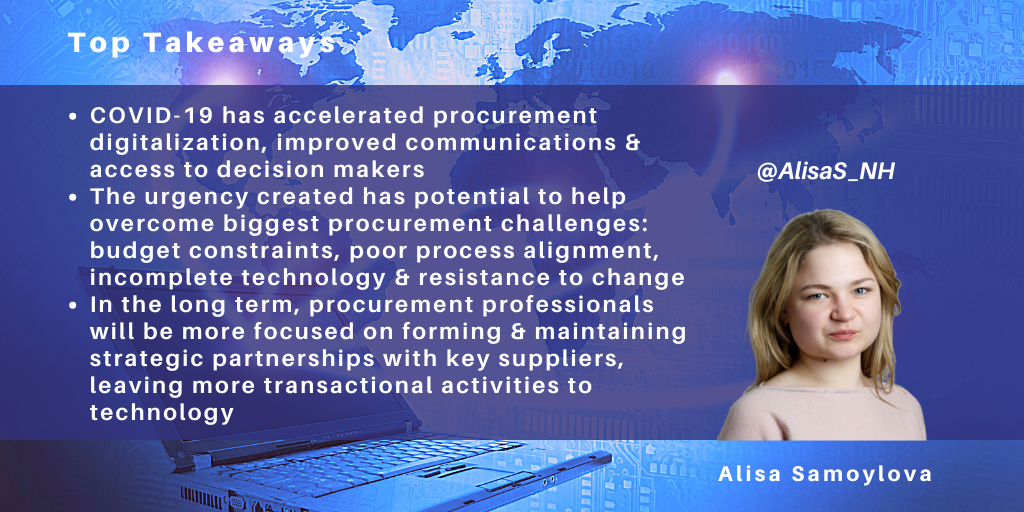
One of the impacts of the pandemic has been a broad acceleration in enterprise digitalization initiatives, and organizations are looking for strategic partners to assist them in their digital transformation journeys. While digitalization is now top of mind even in procurement, historically there have been challenges in applying intelligent automation to procurement, including budget constraints, poor process alignment, incompatible technology, a lack of perceived need, and resistance to change (see here).
COVID-19 has helped drive acceptance of major changes in working practices and increased awareness of the need to free up skilled procurement resources to focus on strategic tasks. Against this background, Capgemini has refocused its procurement offerings in line with its Frictionless Enterprise approach, emphasizing digital.
Addressing the resistance to change
Capgemini’s Digital Procurement Services offering aims to address user adoption by focusing on the user experience. Its Frictionless Enterprise approach places importance on the digitally augmented workforce (see here). Capgemini’s digital procurement services focus on continually supporting end-users, ensuring adoption, supplier engagement (particularly during the onboarding process), and driving catalog content. In addition, Capgemini looks to apply design thinking and customer journey mapping capabilities to the UX in the procurement process, leveraging its expertise in user experience design with recent investments by Capgemini’s consulting group, including Frog Design.
Addressing the disconnect within procurement
With its Frictionless Enterprise approach, Capgemini looks to address any friction points between departments, functions, applications, data sources, devices, etc. As part of its digital procurement offering, Capgemini uses the concepts of Frictionless Enterprise to:
- Determine the objectives of the procurement transformation and align with the overall strategy for the function
- Assess opportunities for channel, spend, and working capital optimization
- Develop and deploy a frictionless operation model through the use of technology and analytics
- Deliver the operating model by leveraging Capgemini’s nearshore and far shore resources, as well as RPA
- Govern through implementing Capgemini’s Command Center.
For procurement, addressing friction points is vital for it to become a more integrated function internally and improve the alignment of procurement with other business units. Capgemini’s digital procurement offering targets the CPO, typically tasked with improving this alignment. In contrast, its digital P2P offering is typically targeting finance stakeholders. Digital procurement takes the lead on the end-to-end procurement transformation deals and leverages the tools and technologies available on the market, applying analytics and IA to drive consistency.
While procurement platforms and P2P process automation are common, the uptake of intelligent automation supporting sourcing activities has been slow to date. To address this, Capgemini has:
- Increased collaboration across the Capgemini Group, which brings more strategic capabilities, such as upfront operating model design, category management, and strategy
- Partnered with emerging technology providers, such as Fairmarkit, a smart sourcing platform for tail-end spend, Globality for autonomous sourcing of services, and Beeline, a vendor management system focused on services
- Added functionality to its analytics services to support the upstream procurement process, e.g., savings tracking and commodity tracking to track indices based on proprietary and open-source data
- Established a global sourcing CoE with locations in Latin America (to service Americas), Europe (Krakow), and APAC (Chennai/Nanhai) for buying request management.
Looking ahead, Capgemini plans to:
- Expand its iValua capability within business services as a core platform for delivery, alongside existing capability across Capgemini
- Continue to establish partnerships with key technology partners such as risk management, sustainability to support the S2C process
- Strengthen its analytics capabilities by introducing predictive analytics to assist sourcing managers in being better prepared for future spend.
Capgemini looks to deliver its digital procurement services through a plug-and-play cognitive procurement ecosystem to provide a coherent end-to-end digital procurement transformation for its clients. The backbone for the platform already exists, and Capgemini is currently working on adding a front-end workflow layer. The plug-and-play platform will bring together a very broad range of capabilities for an integrated procurement function.
Conclusion
In conclusion, COVID-19 has highlighted the importance of further investment in automation as procurement gains strategic importance. Capgemini’s digital procurement offering leverages its Frictionless Enterprise approach to address key challenges in procurement automation – resistance to change and disconnect within procurement. Although the automation of the end-to-end procurement process remains a challenge, Capgemini has made initial steps and looks to further develop its capability in procurement beyond the P2P.
]]>
It is no surprise that COVID-19 is the main theme of virtual conferences such as Procurecon Indirect that focus on the procurement function. And at NelsonHall we are seeing that the pandemic has sparked a range of inquiries from procurement professionals about the art of what’s possible. One outcome of the pandemic is that it has shifted priorities in large enterprises, with an increased focus on business resilience, additional cost cutting measures, and enabling employees to work in the new environment – all of which have been placing additional demands on procurement departments.
As well as working with existing suppliers to sustain current supply chains, sourcing departments have been looking urgently for new suppliers to minimize any future disruptions. And some organizations have been re-evaluating their category management strategies as COVID-19 has disrupted typical spend patterns. Three things that are helping procurement departments cope with the additional workload are acceleration of digitalization, improved communications, and improved access to decision makers.
The biggest challenges in procurement continue to be budget constraints, poor process alignment, incomplete technology and, of course, resistance to change. But COVID-19 has created an environment where overcoming these challenges may become somewhat easier.
Acceleration of digitalization
The acceleration of already rapidly developing digitalization initiatives has been another obvious consequence of the pandemic. Organizations that were more technologically advanced at the start of the crisis have found it easier to cope with changes.
Looking at analytics, for example, there is an acceleration in the shift from using descriptive and diagnostic tools to leveraging predictive and prescriptive analytics. Procurement organizations are increasingly investing in data analysis and scenario analysis software to be able to predict and respond faster to any changes to the supply chain.
Similarly, demand for risk management tools has grown since supply chain risk management and contingency planning continues to be top of mind, with many large organizations looking as far as tier 2 and 3 suppliers.
And there is increased interest in the use of intelligent automation and AI in buying, something that had not really been well developed prior to the COVID-19 crisis.
Improved communications
In an environment where face-to-face meetings have essentially disappeared, procurement organizations in most large enterprises have found that communications with their major suppliers have in fact improved, as e-meetings make it possible to speak with a large number of suppliers across continents over one day; travel time has reduced, and even remote supplier audits have been possible. Although global collaboration is easier, organizations are still more likely to give priority to local suppliers, as long supply chains are unfavorable in the new environment. Some large enterprises with operations in the EU, for example, are moving to country-based systems, disrupting existing supply chains.
With improved communications, some procurement specialists have increased their focus on relationship-building with their suppliers in order to minimize risks associated with supply chain disruption. They have spent time on increasing trust by gathering data on COVID-19-related business continuity plans from their suppliers, as well as establishing new relationships with suppliers who can provide cover should an existing supplier fail to cope with demand, or if the supply chain is disrupted in some other way.
Faster decision-making
Global supply chain disruption has meant that procurement departments have been forced to become more agile and act faster. Longer-term projects became secondary and short-term wins were given preference. Since decisions had to be made faster, procurement, in some enterprises at least, has gained easier access to top level management, and the level of bureaucracy involved in the decision-making process has been greatly reduced.
The impact of these decisions is also being made obvious more quickly, which allows for fine-tuning, ultimately reaching a better outcome for all parties involved. Moreover, some procurement departments are seeing tangible benefits from shorter and more frequent meetings both internally and with their supply chain partners, again including reduced decision-making time.
Repositioning of procurement function within organizations
In some organizations, senior execs are now seeing the procurement function as more of a strategic value-driving function, not just as a cost cutting center. With the crisis, the self-confidence of some procurement execs has increased, and they are using the momentum created by COVID-19 to drive further cultural and organizational changes.
Improved communication has the potential to strengthen relationships, with suppliers delivering value by leveraging core competencies to stand out in the market. Once they see you as a customer of choice, suppliers are also more willing to develop and invest in R&D, which reduces the budget required for transformation. Moreover, by better understanding and managing core suppliers, procurement departments can play a role in creating more transparent supply chains and even achieving supply chain sustainability.
Conclusion
After a period of adjustment, COVID-19 has helped accelerate already existing trends in procurement, and more emphasis is being placed on building stronger relationships and using suppliers’ expertise as a source of competitive advantage. And with the procurement function gaining strategic importance and offshoring becoming increasingly risky, further investment in automation will be the key to ensuring business resilience and agility in the future. All in all, the transformation of some large enterprise's procurement function may happen earlier than anticipated at the beginning of the year.
Alisa has just started a major global research project on transformation in enterprise procurement, scheduled for publication in Q1 2021. She would be interested in hearing from leading suppliers and buyers of enterprise procurement services, and can be contacted at [email protected] and @AlisaS_NH.
]]>